Notophthalmus viridescens
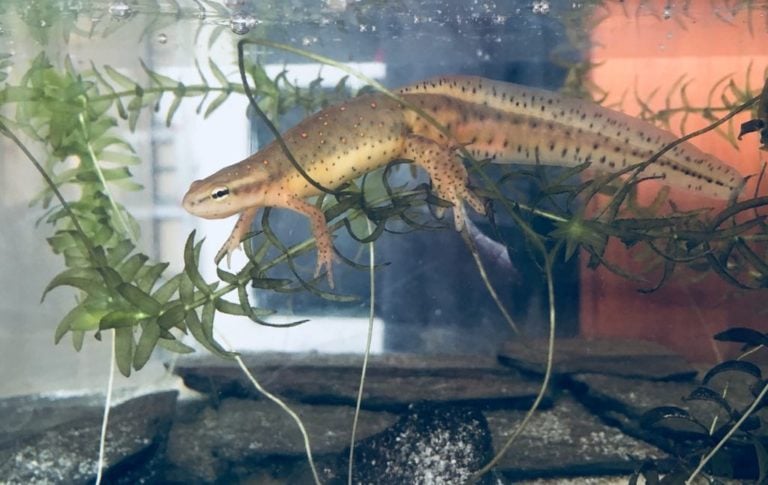
Description:
Notophthalmus viridescens is a newt of slight build with a maximum length of 14cm. The colouring is generally brownish-green, with marbling, spots or punctuation. On a dorsal paramedian position, there can be various ocelli of a red/orange/yellow colour inside a black ring. The belly is pale yellow, thickly dotted. The eye is yellow, with a horizontal pupil and a dark band that runs through it.
The males are very easily recognizable from the females thanks to the greater development of the hind limbs, fundamental for the amplexus. These increase further in size during the reproductive period with corns and hyperkeratinized areas appearing on the fingers and the medial part of the hind legs. Also, a bland caudal crest develops in both sexes, although smaller in females.
If disturbed, they assume a “terrifying” position, arching the back upwards and bringing the head close to the tip of the tail: the unken reflex.
A peculiar characteristic of this species is the “double metamorphosis“. The young may differ considerably from the adults and present an intermediate stage called eft (or red-eft), with red-orange colouring all over the body. This particular feature seems to be a form of Aposematic Mimicry, given the remarkable toxicity of the individuals of this species.
Curiously, a member of the Plethodontidae family, Pseudotriton ruber, seems to have developed his vivid colouring just as an “imitation” of red-efts, a phenomenon known as Batesian Mimicry.
From a molecular analysis, it is known that Notophthalmus viridescens is one of the most toxic urodeles, second only to Taricha sp. when it comes to TTX, 6-epiTTX and 11-deossiTTX secretions. The juveniles are roughly 10 times more poisonous than the adults, with between 0.014 to 0.11 mg of TTX in their skin. As evidence of this, compared to most of the juveniles of other caudates, the period of activity of the Eft is decidedly diurnal, with very high densities of individuals moving in the forest litter. Interestingly, a study found a positive relationship between the number of ocelli and the overall toxicity of the newt, despite the ocelli not being in themself more poisonous than the rest of the skin. The ocelli seem to have an integral part in indicating the toxicity of the animal to predators, as well as a role in discerning the fitness of a male by the female, with adults males having usually redder ocelli, and bigger males having more ocelli than smaller males.
Sometimes, however, especially in some populations, the eft stage is skipped. In this case, the juveniles will have a colour much more similar to that of the adults and may also remain predominantly / totally aquatic.
Four subspecies of Notophalmus viridescensis are currently described, but recent genetic analysis does not seem to support the differentiation between subspecies. Judging from the genetic analysis, the subspecies are currently highly adapted populations with phenotypical differences which have only very recently developed, with very small genetic differences. While these differences may continue to develop with time, gene swaps among populations and subspecies are still possible.
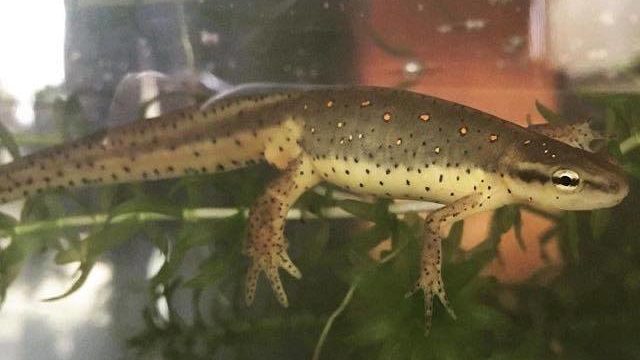
The Notophthalmus viridescens viridescens is the largest subspecies, reaching up to 14 cm (however, usually less). The very common eft stage has the brightest colouration of all the other forms. Its range extends from the states of Georgia, Alabama, Mississippi, and then north to the north-eastern area of Canada.
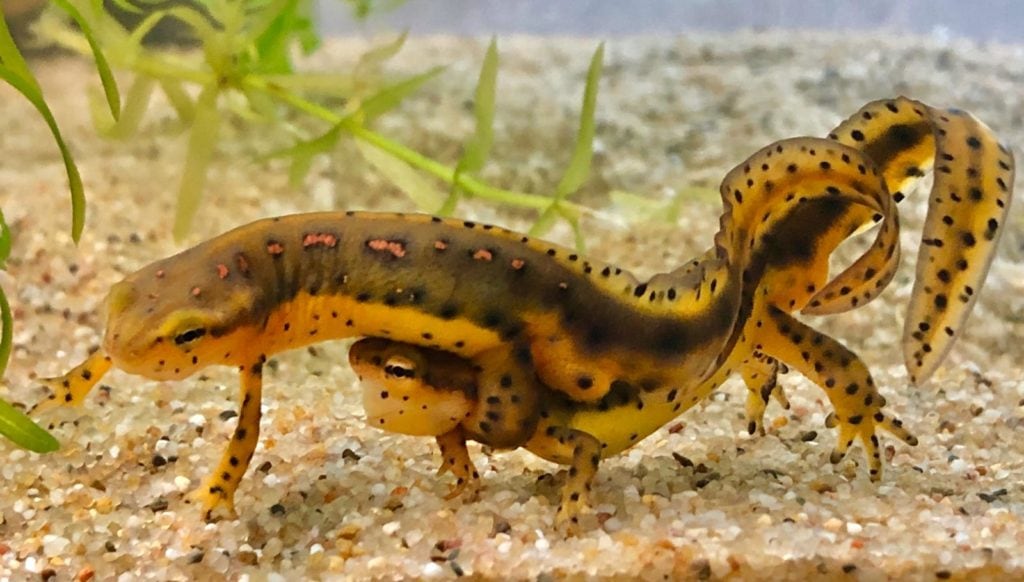
The Notophthalmus viridescens dorsalis is the smallest form, measuring just 10cm. Its characteristic is the ocelli that tend to unite to form irregularly fused spots along the parasagittal lines. The eft stage is present, but with a less bright colour than that of the nominal shape. It is found in the Carolina region.
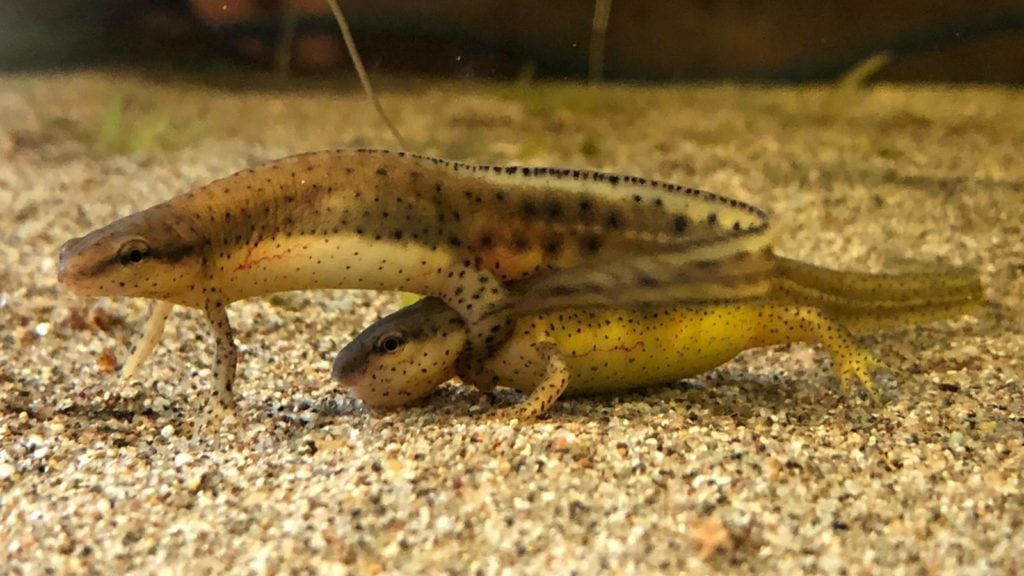

Notophthalmus viridescens piaropicola is one of the smaller forms, measuring about 10.5cm. It is more slender than the nominal and devoid of the ocelli of the nominal and with a much darker background colour. The eft stage is absent, with the juveniles looking like the adults. It is found only in the Florida peninsula.
Habitat:
Eastern regions of the USA, in continuity with the southernmost regions of Canada. Adults colonize any body of water, permanent or otherwise, with or without fish (given their high toxicity, fishes do not represent a big problem).
Care in Captivity:
In nature, adults tend to be aquatic, except in conditions of desiccation and/or strong heat. In winter, however, they are always found active even under the ice cover, therefore they can be safely raised in an aquarium, equipped with a small emerged area, to allow the animals to go out when they wish.
The size of the tank will obviously depend on the number of individuals housed but indicatively a 60x30x30cm will be fine for 4 adults.
The substrate may be completely absent or made up of fine sand/gravel. Numerous plants are recommended, of any species that suits their needs. Submerged woods and stones are also very useful to create shelters. Given the presence of plants (highly recommended with this species), an artificial, neon or LED light source will also be needed.
A filter, on the other hand, is an optional accessory, given that this species often colonize still waters and, if inserted, the pump power needs to be regulated to a minimum.
For the water column, it is better to have at least 20cm, since individuals of this species can be found even at higher depths.
Ideal breeding temperatures fluctuate around 15-24°C. During brumation, this can be brought to temperatures below 5°C, while in summer it is better not to exceed 24°C. However, higher temperatures can still be well tolerated, especially with more southern populations (personal observation).
Diet:
Adults generally eat whatever is given to them: earthworms, gammarus, artemia, bloodworms, asellids, big-scale sand smelt, tubifex, enchytraeus, daphnia, ostracods, earthworms, freshwater fish, shrimps.
If they were to return or remain terrestrial instead a well-balanced diet will have to include: crickets, cockroaches, earthworms, waxworms, mealworms, isopods, woodlice.
Often and suddenly though, there can be long and worrying episodes of lack of appetite and inappetence, especially in newly purchased animals.
Reproduction:
Very simple to reproduce, it needs a period of brumation from a few weeks to a few months. In this period a significant decrease in temperature and/or photoperiod is indispensable. The easiest and undoubtedly the most natural way to do this is to move the tank directly outdoor. As written above, temperatures below 0°C can easily be tolerated, but caution should be taken to prevent the complete freezing of the water column. The formation of even 2-3cm of ice on the surface is not problematic. The animals, in fact, react to the lowering of the temperature by drastically reducing their metabolism. It is preferable to leave the animals outside for about 1-3 months and then bring them back home.
While moving the newts outside, care must be taken to avoid sudden changes in temperature, so it is best to do these manoeuvres late in the morning, to gradually get the animals used to the new temperatures. Even better, they can be moved in the fall, bringing them back in the spring.
The brumation, however, can be obtained quite easily even at home, simply by placing the animals in a refrigerator or wine cellar. Even a simple cellar can sometimes be enough, as long as you can reach temperatures below 10°C. Opting for the refrigerator, the big drawback will be the impossibility of seeing the animals. In this case, it is not recommended to open and close the refrigerator due to changes in temperature or to additional stress on the animals.
It is important, however, to check the specimens daily and above all to check that the substrate never dries up.
After a few weeks in brumation, we will begin to observe the first courtships, very particular compared to the rest of the urodeles. This is physical and peculiar: the male grabs the female with the hind limbs at the axillary level. At this point he will begin to rub his snout on that of the female, rhythmically undulating at the same time the tail, freeing pheromones. The duration of this embrace can last several hours and is not without risks for the female who could also drown. It is therefore advisable to keep a sex ratio shifted in favour of the females, precisely to avoid excessive stress or even death.
>After amplexus, the male will come off and stand in front of the female, undulating the body.
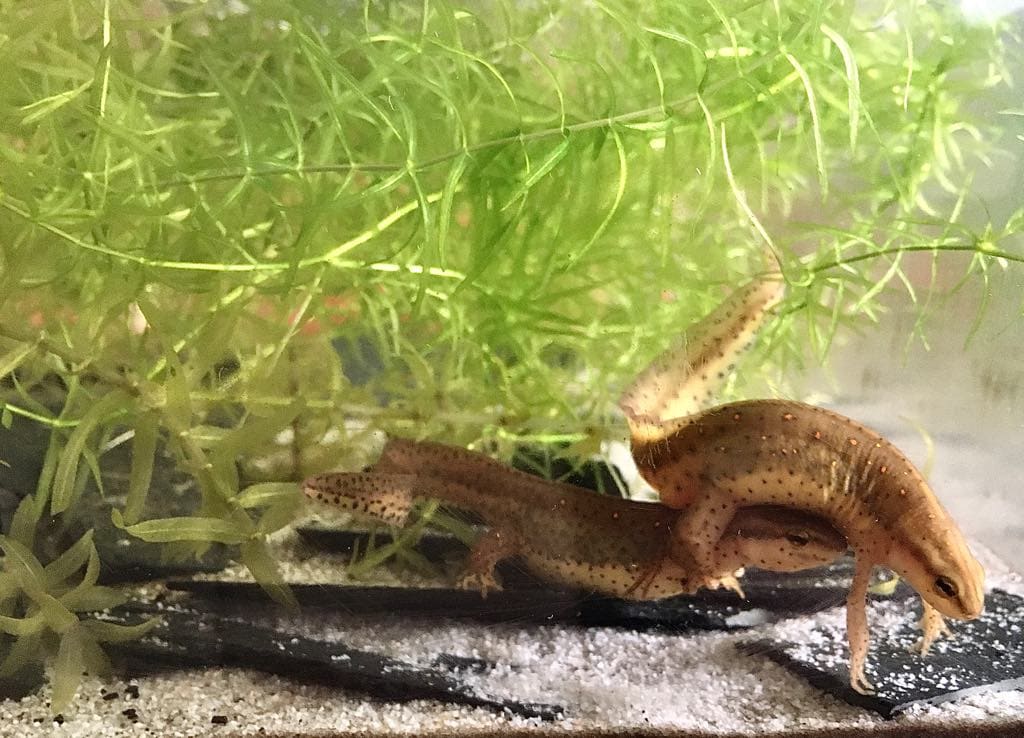
If the female is receptive she will press the tail of the male with her snout, that at this point he will deposit a spermatophore. If she is not receptive, she will simply run away. Once the courtship phase has passed, the females will begin to lay up to over 350 eggs, especially on the submerged vegetation, but potentially on any surface: glass, rocks, wood, substrate, etc.
It is advisable than to take the eggs and raise them separately until they hatch which, at temperatures of around 20°C, will occur in about 10-15 days.
For this species, it is not necessary to brumate the two sexes in separate tanks, nor to put the males in the water first and the females after a few days.
Care of larvae:
The larvae will not feed for a few days after hatching, supporting themselves entirely with the reserves of the yolk sac. After this period (usually 3-5 days), they will begin to feed on aquatic and strictly live micro invertebrates.
For the first month, hygiene must be scrupulous and daily, removing faeces, scraps and more with the aid of a pipette/syringe and providing for partial water changes of about 20%, every 24h. Never make total water changes, otherwise, there is a risk of death due to osmotic/chemical stress. Also take care not to include predators as nymphs of odonates, larvae of dytiscidae but also ostracods.
As the larvae grow, they will then need to be periodically divided by size, to minimize the risks of cannibalism, although it is still a relatively quiet species from this point of view. In the meantime, it will be necessary to start diversifying the preys by guaranteeing, among the many, daphnia, ostracods, artemia, tubifex, white worms, vinegar eel, bloodworms, mosquito larvae, small gammarids, nymphs of ephemeroptera, etc. Furthermore, more or less in conjunction with the complete development of the lower limbs, inert/defrosted food may be started.
The end of the larval stage will be concomitant with a series of signals: the skin will begin to pigment and resemble more closely the adults, the morphology of the skull will be more defined, the legs will be strengthened, the caudal membranes will be completely reabsorbed, as will the gills. Also, the larvae will begin to moult.
The signals to be most relied upon to change keeping parameters will be: moult and thinning of the caudal membranes. Seeing these 2 signals, it will be good to lower the water level to less than 1cm, set up a sufficient number (high!) of emerged areas and equip the breeding tank with an escape-proof lid.
The presence of even more or less developed gills can be misleading, given that often juveniles emerge from the water with only partial reabsorption of this organ. The larval phase on average has a duration of 3-6 months, although neotenic individuals are also quite common. At the time of the metamorphosis, the juveniles measures about 2cm.
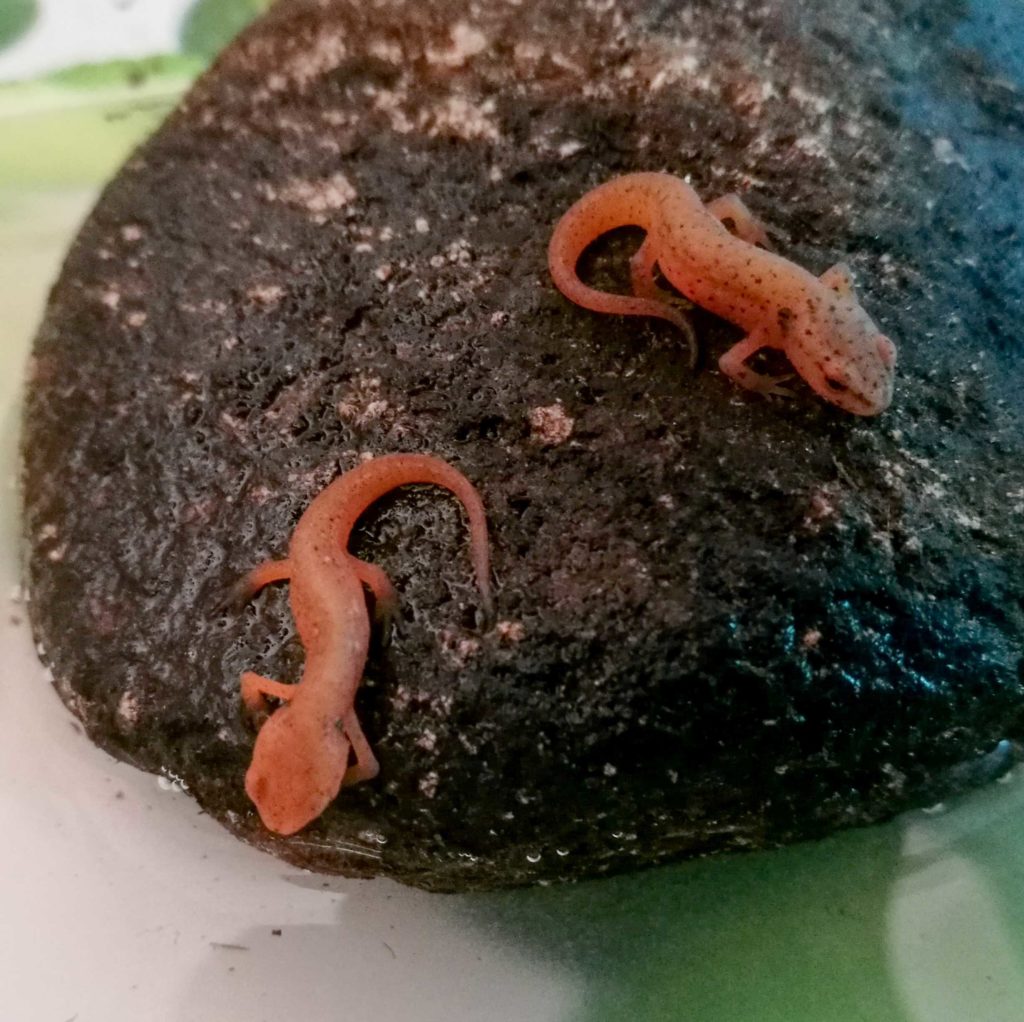
Juveniles:
Once the metamorphosis is completed, the juveniles will usually be entirely terrestrial for at least 2-4 years. Their colouring is very characteristic and often deviates considerably from that of adults, so much so that they are commonly referred to as “red eft“. This stage is often present above all in the subspecies viridescens and dorsalis, where the metamorphosed specimens take on a more or less marked red colour, a clear indication of animal toxicity.
Over time the colouring will tend to fade towards the typical livery of adults. The subspecies piaropicola and lousianensis, as well as in some cases the others, often skip this phase, simply becoming miniature copies of adults, albeit with a lighter colour.
In any case, the keeping is identical: terrestrial until sexual maturity. Therefore we will have to equip ourselves with live food of the appropriate size, including springtails, fruit flies, hatchling crickets, cockroach nymphs, woodlice, weevils, white worms, etc. If the animals are used to it, we can also use inert food.
The terrarium may consist of wet kitchen paper substrate and some hiding places or, in a more naturalistic way, with soil/peat/coconut fibre (or a mixture of the 3), some wood, rocks, dry leaves and mosses.
Care needs to be placed in maintaining a humidity gradient inside the terrarium (one half wetter than the other) as well as keeping it well ventilated. Of course, there will need to be scrupulous attention to hygiene.
Some individuals once metamorphosed will remain aquatic. In this case, the juveniles can be maintained in am aquarium similar to the one for the adults, or even a more basic and simple version for ease to inspect the animals and cleanliness.
The keeping of juveniles is generally difficult, especially for the animals that remain terrestrial. Deaths from drowning (even in a few mm of water) are quite common, due to moulting problems as well as a marked susceptibility to infections and lack of appetite for no apparent reason.
Problems and diseases:
In nature, many populations are now infected with Batrachochytrium dendrobatidis although often asymptomatically. So far mass deaths due to this pathogen have not been noticed.
More recently a new parasite has been described, Amphibiocystidium viridescens, which was responsible, especially in winter and spring, for high mortality.
It also appears that Notophthalmus viridescens is a healthy carrier of some viruses of the Iridoviridae family, always asymptomatically.
Availability:
Until recently periodically common, appearing in large numbers from wholesalers and shops, only to disappear again even for long periods of time. To date, the status of the species in the captivity is still precarious.
Despite the many imports, the difficulty in finding healthy individuals and in the growth of metamorphoses has hindered its spread, which still remains fairly niche.
In Europe, the most common available subspecies are N.v.viridescens and N.v.louisianensis, while the other subspecies are nowadays almost impossible to find.
Legislations:
They are not subject to any legislation.
Difficulties:
The main difficulty with this species lies in the fact that almost all the adult animals on the market are wild-caught. This has as main consequences the risk of having to deal with highly stressed animals and/or with serious diseases. Cases of necrosis of the extremities, which can rapidly degenerate leading to death, are not rare. Or again, cases of even prolonged lack of appetite are frequent, often accompanied by non-resolution and fatal outcomes.
If instead, you can find healthy specimens and possibly born in captivity, the situation changes decisively and the animals once provided with the ideal conditions, will be easy to keep.
Notes:
Undoubtedly it is a fascinating species, both for its colours, and for the way it mates, and for its characteristic “double metamorphosis”. The small size, the ease of breeding and even the decidedly affordable cost of the specimens make it a species potentially suitable for neophytes. On the other hand, juveniles or wild-caught animals are very difficult to keep, making them not ideal inexperienced keepers. Overall, therefore, a species to keep only if you already have some experience in keeping newts.
About the Author...
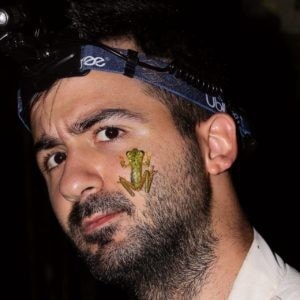
References
Citation: Gabor, C. R., & Nice, C. C. (2004). Genetic variation among populations of eastern newts, Notophthalmus viridescens: a preliminary analysis based on allozymes. Herpetologica, 60(3), 373-386.
Citation: Rothermel, B. B., Walls, S. C., Mitchell, J. C., Dodd Jr, C. K., Irwin, L. K., Green, D. E., … & Stevenson, D. J. (2008). Widespread occurrence of the amphibian chytrid fungus Batrachochytrium dendrobatidis in the southeastern USA. Diseases of Aquatic Organisms, 82(1), 3-18.
Citation: Spicer, M. M., Stokes, A. N., Chapman, T. L., Brodie, E. D., & Gall, B. G. (2018). An investigation into tetrodotoxin (ttx) levels associated with the red dorsal spots in eastern newt (Notophthalmus viridescens) efts and adults. Journal of toxicology, 2018.
Citation: AmphibiaWeb: Information on amphibian biology and conservation. [web application]. 2020. Berkeley, California: AmphibiaWeb. Available: https://amphibiaweb.org/. (Accessed: 2020).